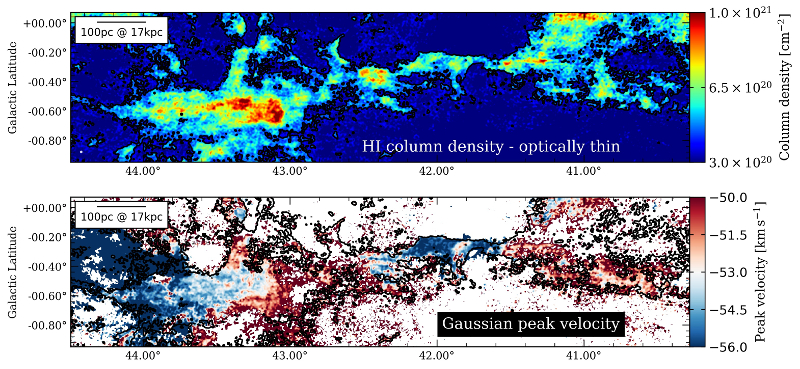
|
EPoS |
|
EPoS Contribution
|
|
Giant Atomic Filaments in the Milky Way
Jonas Syed MPIA, Heidelberg, DE | |
| Atomic hydrogen is crucial to understand early cloud formation processes. Employing the THOR HI data (The HI/OH Recombination line survey of the inner Milky Way), we identified a unique structure; one of the largest, coherent, purely atomic filaments in the Milky Way. We present this giant atomic filament GAF44.0-40.5 ("Maggie") that shows no detection in other bands or signs of active star formation. At the kinematic distance of 17kpc, it has a projected length of ~1kpc and is situated fairly off (δb~500pc) but parallel to the Galactic plane. The velocities show a coherent structure (Fig.1) and the line widths are dominated by turbulent motion. Assuming optically thin emission, "Maggie" has a mass of ~5×105 solar masses. HI absorption against strong continuum emission allows us to disentangle the cold neutral medium from its warm component and shows that the filament is dominated by cold gas. This unique structure on the far side of our Galaxy is a powerful laboratory to investigate the purely atomic phase of the interstellar medium. | |
 | |
| Caption: Figure 1: The upper panel shows the integrated HI column density of "Maggie" assuming optically thin emission. The lower panel shows the velocity structure of the filament. It is derived from Gaussian fits to the HI emission spectra around vlsr~ -54.0 km/s. The black contours in each panel indicate the 5σ level of the HI column density. | |
| Collaborators: H. Beuther, MPIA, DE Y. Wang, MPIA, DE J.D. Soler, MPIA, DE |
Suggested Session:
Molecular Clouds |